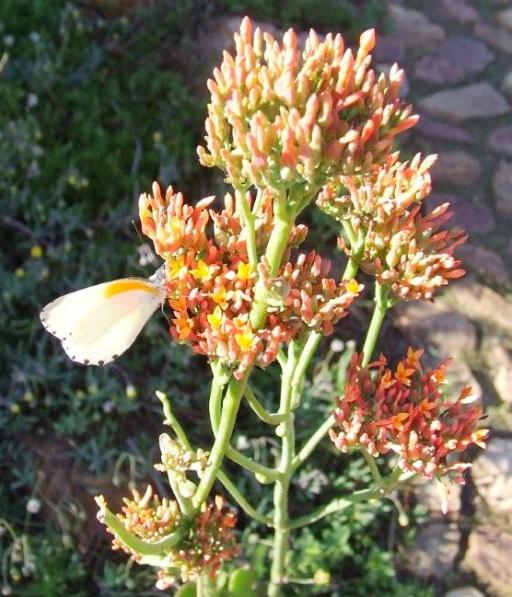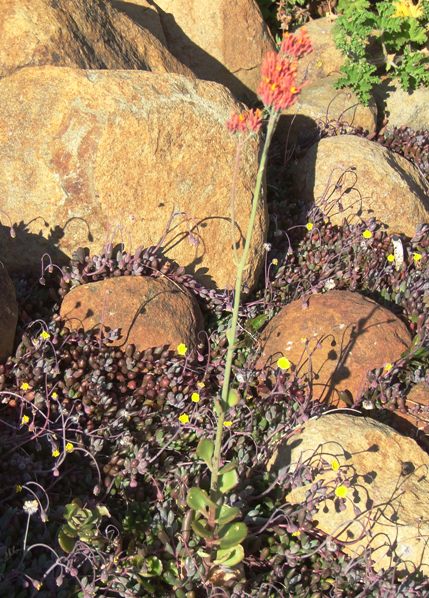

1. New Albums and some changes
The latest Albums on genera of South African plants added to the Operation Wildflower Site are the ones on Cyrtanthus, Dicoma and Strumaria. This means that photos and stories of plants belonging to these genera already on the Site, together with some new ones, have been moved from the more general Albums called Bulbs and Herbs respectively into their own new Albums under Genera.
There is a genus Album in every case where enough material has been accumulated to warrant a stand-alone grouping of photos and stories. There are now more than 220 such genera Albums. The biggest ones (most photos) belong to the genera Crassula, Euphorbia, Pelargonium, Aloe and Erica. Keep watching, more will be added. If there is no genus Album yet on the plant you are looking for, check under Types, the grouping that the Site was started off with, accessible via the pictured items shown on the right. The Search Box may yield more, for plants and related material are also shown in Albums on Habitat, Regions and Parks and Gardens.
In order to access items on a plant of interest, enter its botanical name in the Search Box. Entering other words or names will access what is contained in the Albums database. The latest Regions Album is the one on Nature's Valley and the latest Parks and Gardens Album is on Tietiesbaai also known as the Cape Columbine Nature Reserve.
2. Want to talk about a plant or an Album item?
There is a new way of communicating with the Editor of this Site regarding any of the Album Items.
Comments, questions, corrections, information and suggestions can be put to the Editor by using the following email address: This email address is being protected from spambots. You need JavaScript enabled to view it..
Please ensure that the Album Item concerned is clearly identified. Type its exact title as well as the Album Name in the Subject Line of your email. Please also state your name.
Similarly, communication regarding the functioning or technical aspects of the Site can be directed to the Webmaster at: This email address is being protected from spambots. You need JavaScript enabled to view it..
3. Reduced Mobile Site for Cell Phone Users
Operation Wildflower now also offers a reduced Mobile Site for cell phone use that only presents the Albums contents. This is aimed at overcoming display difficulties on some of the mobile devices in use for quick reference. The reduction found in the Mobile Site doesn't affect the full set of photos and stories of Operation Wildflower, only in diminishing the Site's secondary details that may make it hard to access the items on a small screen.
It is best to use the normal or full Operation Wildflower Site on computers, iPads and devices with bigger screens, as well as those that present unimpaired display of full details and access to all material on offer.
Should viewing difficulties be experienced on your device, click here to access the Mobile Site.
4. Subject Index
A Subject Index of a selection of topics touched on in Album Item text has been started, other than plant species. Access it via Information.
The Album Item Title should be clicked upon to open the Item dealing with the Topic.
Check in the Search Box for yet more subjects not added to the Subject Index list yet.
| Botanical name | Kalanchoe rotundifolia |
| Other names | Nenta |
| Family | Crassulaceae |
| Dimensions | Erect succulent of about 40 cm in height, can grow to 1 m |
| Description of stem | Soft, light yellow-green to grey-green, sometimes pinkish on lower part, erect from a leafy base, opposite leaves along the stem, reducing in size and increasingly further apart on the way up; limited branching at the base occurs |
| Description of leaves | Succulent, round, ovate or obovate, smooth, light green to blue-green, sometimes pink in parts; a whitish bloom is sometimes evident; leaf margins are entire, attenuating at base; in the Gauteng area the round leaf form is rare; the bigger leaves are clustered near the base of the stem |
| Description of flowers | The inflorescence is a panicle of many small tubular, four-petaled, red or orange flowers at the top of the erect central stalk; flowers appear in autumn into the beginning of winter, but some variation occurs with the region; |
| Desciption of seed/fruit | Oblong, four-angled capsule |
| Description of roots | Rather short, fine roots |
| Variation | As sometimes found in plants with a large natural habitat, the plants vary considerably, notably in leaf shape, flower colour and time of flowering |
| Propagation and cultivation | Can be grown from seed, often seeding itself once it is established in an area; the basal leaves tend to form new leaves and form new plants spontaneously, the old basis sometimes persisting and supporting the leaves that sprout new plants in spring; some old plants will survive into a second and third year; cuttings from the base of older plants or the soft tips grow easily in sandy soil, semi-shade and with mild watering |
| Tolerances | |
| Uses | Garden plant suitable for low watering and maintenance conditions, grows well among trees, also in limited sunlight |
| Ecological rarity | Common |
| Pests and diseases | Not under much attack in its natural domain |
| Other | This plant is a danger to livestock, notably goats and sheep, as it contains the same or similar poisonous substances as the Cotyledon species that cause loco disease or nenta |
| Location | Often in colonies close to or in the shade of trees and shrubs; in sandy soil of differing composition |
| Distribution (SA provinces) | Gauteng; Mpumalanga; KZN; North West |
| Country | South Africa; Zimbabwe |









